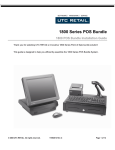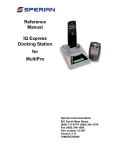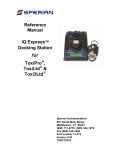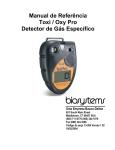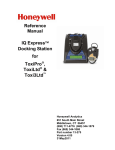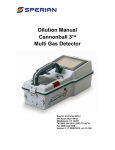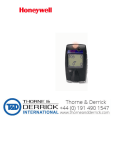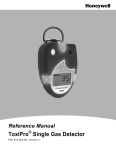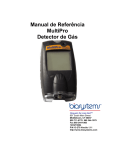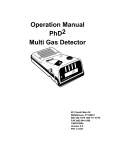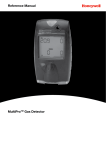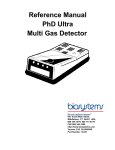Download Biosystems ToxiLtd®
Transcript
Biosystems ToxiLtd® Single Gas Detector Reference Manual Sperian Instrumentation 651 South Main Street Middletown, CT 06457 (800) 711-6776 (860) 344-1079 Fax (860) 344-1068 Part number 13-266-N Version 3.00 1Nov2009 0 THE BIOSYSTEMS TOXILTD-NGSG® PERSONAL PORTABLE GAS DETECTORS HAVE BEEN DESIGNED FOR THE DETECTION AND MEASUREMENT OF POTENTIALLY HAZARDOUS ATMOSPHERIC CONDITIONS. IN ORDER TO ASSURE THAT THE USER IS PROPERLY WARNED OF POTENTIALLY DANGEROUS ATMOSPHERIC CONDITIONS, IT IS ESSENTIAL THAT THE INSTRUCTIONS IN THIS REFERENCE MANUAL BE READ, FULLY UNDERSTOOD, AND FOLLOWED. ® Biosystems ToxiLtd-NGSG Reference Manual Sperian Instrumentation Part Number 13-266-N Version 3.00 Copyright 2009 by Sperian Protection Instrumentation, LLC Middletown, Connecticut 06457 All rights reserved. No page or part of this operation manual may be reproduced in any form without written permission of the copyright owner shown above. Sperian Instrumentation reserves the right to correct typographical errors. 1 Table of Contents Certifications ...................................................................................... 3 Warnings and Cautions ..................................................................... 3 A. B. Signal Words............................................................................................................3 Warnings..................................................................................................................4 1. Overview ....................................................................................... 5 1.1 Methods of sampling ............................................................................................5 1.2 Sensors ................................................................................................................5 1.2.1 Sensor ranges and resolutions. ...................................................................5 1.2.2 F1: Missing sensor during startup ................................................................5 1.3 Alarm logic ...........................................................................................................5 1.3.1 Gas alarms...................................................................................................5 1.3.2 Silence warning alarms ................................................................................6 1.3.3 Calibration due notices.................................................................................6 1.3.4 Low battery alarms.......................................................................................6 1.3.5 Heartbeat Feature ........................................................................................6 1.4 Design components .............................................................................................6 1.5 Standard accessories ..........................................................................................6 1.6 Value pack kits .....................................................................................................6 2. Field Operation............................................................................. 7 2.1 Turning the ToxiLtd on .........................................................................................7 2.1.1 Toxic version start up sequence ..................................................................7 2.1.2 Start up sequence ........................................................................................7 2.2 Functions .............................................................................................................8 2.2.1 View time remaining, max gas readings, time in alarm, calibration due.......8 2.2.2 View alarm levels .........................................................................................9 2.3 Calibration due notices ........................................................................................9 2.4 Low battery alarms...............................................................................................9 2.5 Turning the ToxiLtd off .......................................................................................10 2.6 Sampling ............................................................................................................10 2.6.1 Sample draw kit usage...............................................................................10 3. Calibration .................................................................................. 10 3.1 Verification of accuracy ......................................................................................10 3.1.1 Verifying toxic sensor performance ............................................................10 3.2 Effect of contaminants on ToxiLtd sensors ........................................................11 3.2.1 Effects of contaminants on toxic gas sensors ............................................11 3.3 Fresh air/zero calibration ...................................................................................11 3.4 Functional (bump) testing for ToxiLtd with toxic gas sensor ..............................12 3.5 Span Calibration for ToxiLtd with toxic gas sensor ............................................12 3.6 Failure to calibrate .............................................................................................13 3.6.1 Fresh air/zero calibration failure.................................................................13 3.6.1.1 3.6.2 3.6.2.1 3.6.2.2 3.6.2.3 Reason for fresh air/zero calibration failures ......................................................13 Span calibration failure...............................................................................13 Sensor out of range (no CAL).............................................................................13 No gas.................................................................................................................14 Causes for span cal failure .................................................................................14 3.6.3 Forced fresh air/zero calibration.................................................................14 3.7 Fresh air/zero calibration in a contaminated atmosphere ..................................14 4. Event logging ............................................................................. 14 2 4.1 Initiating communications...................................................................................15 Appendices ....................................................................................... 16 Appendix A: Sensor Cross-Sensitivity Chart .................................................................16 Appendix B: Default toxic sensor calibration gas settings .............................................16 Appendix C: Calibration Frequency ...............................................................................17 Sperian Instrumentation Warranty Gas Detection Products........ 18 Certifications ® The ToxiLtd-NGSG carries the following certifications: UL and c-UL, Class I, Division 1, Groups A,B,C,D, Temp Code T4. UL Class II, Division 1, Groups E,F,G ATEX Certification: II 2 G Ex ia IIC T4 UL International DEMKO A/S 09 ATEX 0823124 IECEx Ex ia IIC T4 Warnings and Cautions A. Signal Words The following signal words, as defined by ANSI Z535.4-1998, are used in the ToxiLtdNGSG Operator’s Guide. indicates an imminently hazardous situation which, if not avoided, will result in death or serious injury. indicates a potentially hazardous situation which, if not avoided, could result in death or serious injury. indicates a potentially hazardous situation, which if not avoided, may result in moderate or minor injury. CAUTION used without the safety alert symbol indicates a potentially hazardous situation which, if not avoided, may result in property damage. 3 B. Warnings 1. The ToxiLtd personal, portable gas detectors have been designed for the detection of either oxygen deficiencies or specific toxic gas accumulations. An alarm condition indicates the presence of a potentially lifethreatening hazard and should be taken very seriously. 2. In the event of an alarm condition it is important to follow established procedures. The safest course of action is to immediately leave the affected area, and to return only after further testing determines that the area is once again safe for entry. Failure to immediately leave the area may result in serious injury or death. The accuracy of ToxiLtd instruments should be checked periodically with known concentration calibration gas. Failure to check accuracy can lead to inaccurate and potentially dangerous readings. A ToxiLtd equipped with a toxic gas sensor that fails calibration may not be used until testing with known concentration test gas determines that accuracy has been restored, and the instrument is once again fit for use. An instrument that cannot be calibrated or is found to be out of tolerance must be replaced immediately. Do not reset the calibration gas concentration setpoints in the ToxiLtd unless the concentrations of your calibration gas differ from the concentrations of the calibration gas that is normally supplied by Sperian for use in calibrating the ToxiLtd. Use of non-standard calibration gas and/or calibration kit components when calibrating the ToxiLtd can lead to dangerously inaccurate readings and may void the standard Sperian warranty. Sperian offers calibration kits and long-lasting cylinders of test gas specifically developed for easy calibration. Customers are strongly urged to use only Sperian calibration materials when calibrating the ToxiLtd. Substitution of components may impair intrinsic safety. 3. 4. 5. 6. 7. For safety reasons the ToxiLtd must be operated by qualified personnel only. Read, understand and follow the directions set forth in this reference manual before operating the ToxiLtd. The ToxiLtd has been tested for intrinsic safety in 9. Explosive Gas/AIR (max. 21.0% O2). 8. 10. Do not open the ToxiLtd. There are no user serviceable parts inside of the instrument. 4 1. sensor for the instrument to register a reading. In diffusion mode, the atmosphere reaches the sensor by diffusing through the sensor port on the front of the instrument. Normal air movements are enough to carry the sample to the sensor. During remote sampling, the gas sample is drawn into the sensor compartment through the probe assembly and a length of tubing. See section 2.6 for more details on sampling the atmosphere. 1.2 Sensors The ToxiLtd uses an electrochemical toxic gas sensor which has been designed to minimize the effects of common interfering gases. These sensors provide accurate, dependable readings for gases commonly encountered in industrial applications. 1.2.1 Sensor ranges and resolutions. Overview The Biosystems ToxiLtd hereafter referred to as the ToxiLtd is a single sensor gas detector that is designed to detect either carbon monoxide (CO) or Hydrogen Sulfide (H2S). The ToxiLtd’s sensor type is shown on the front of the instrument and is also shown on the display during the startup sequence or during Gas Indicator mode. ToxiLtd gas detectors are disposable instruments that are designed to operate for 2 full years from the date of activation. ToxiLtd models must be activated within 6 months of the manufacturing date. If the instrument is not turned on by the “must be activated by date”, the instrument will activate itself and the 2-year countdown will begin automatically. Upon delivery, the screen of the ToxiLtd will be blank except for the negated horn icon. Sensor Range CO H2S 0-1000 PPM 0 -200 PPM Resolution 1 PPM 1 PPM 1.2.2 F1: Missing sensor during startup If the ToxiLtd fails to detect the sensor during startup, it will show “F 1” with the caution symbol following the software version screen at startup. This is covered in greater detail in section 2.1.3. 1.3 Alarm logic 1.3.1 Gas alarms When an alarm set point is exceeded a loud audible alarm sounds, the bright red LED alarm light flashes and the display will indicate whether it is a warning alarm or a more serious danger alarm. If the ToxiLtd is equipped with the optional vibrating alarm, it will also be activated during an alarm condition. Instruments have two ascending alarm set points. The lower alarm set point is the warning alarm, while the higher alarm set point is the danger alarm. If the “must be activated by date” has passed and the instrument has activated itself, the instrument will show three lines on the screen with the negated horn icon. Contact Sperian or your distributor if three lines are displayed when you first receive the detector. The ToxiLtd is delivered with a preinstalled lithium thionyl chloride (LiSOCl2) battery capable of powering the instrument for the full 2 years of the instrument’s operating life unless the instrument exceeds the allotted alarm time. After the 2-year instrument life cycle is up, the instrument will turn itself off. Sensor CO H2S 1.1 Methods of sampling The ToxiLtd may be used in diffusion mode, or with the manual sample draw kit that is available separately. In either mode, the atmosphere must reach the Warning Alarm 35 PPM 10 PPM Danger Alarm 100 PPM 20 PPM Default Warning and Danger Alarm Settings 5 Front face: The front face of the instrument houses the LCD display, MODE button, sensor port, LED and audible alarm port. LCD display: The liquid crystal display (LCD) displays gas readings, messages and other information. Visual alarm (LED) / IrDA port: A bright red LED (Light-Emitting Diode) alarm light provides a visual indication of the alarm state. The LED also functions as the IrDA port. MODE button: The large push-button on the front of the instrument is called the MODE button. The MODE button is used to turn the ToxiLtd on and off, to view the MAX screen and to initiate the automatic calibration sequence. In the event of an alarm condition it is important to follow established procedures. The safest course of action is to immediately leave the affected area, and to return only after further testing determines that the area is once again safe for entry. Failure to immediately leave the area may result in serious injury or death. 1.3.2 Silence warning alarms The ToxiLtd’s audible and vibrating (if so equipped) alarms can be turned off during an alarm condition by pressing the MODE button if this function has been enabled with BioTrak software. The visual warning alarm light and readings will continue to indicate the alarm. 1.3.3 Calibration due notices The ToxiLtd includes calibration due notices that are displayed when the instrument is due for calibration. For more information on the calibration due notices, see section 2.3. 1.3.4 Low battery alarms The battery in the ToxiLtd is designed to power the instrument for a full two years from the date of activation as long as the instrument has not exceeded 20 hours in alarm. In the unlikely event that the battery runs out of power prior to the completion of the 2-year operational lifespan, the ToxiLtd includes two battery warning alarms that are activated when the battery voltage is reduced to specific levels. For more details on the battery alarm, see section 2.4. 1.3.5 Heartbeat Feature A blinking heart is an active indicator, notifying the user that the instrument is operating normally. Figure 1. Exterior front view. Sensor port: The sensor port is located at the upper left corner of the instrument. A filter prevents unwanted contaminants from entering the sensor. Audible alarm orifice: A cylindrical resonating chamber contains the loud audible alarm. Bottom surface: The belt clip attaches to the bottom surface of the instrument. 1.5 Standard accessories Standard accessories with every ToxiLtd include installed sensor and battery, reference manual and calibration/sample draw adapter. 1.6 Value pack kits ToxiLtd value packs include all standard accessories, calibration fittings, 34-liter cylinder of calibration gas, and fixed flow rate regulator in a foam-lined, hard-shell carrying case. 1.4 Design components Case: The instrument is enclosed in a solid PC (polycarbonate) case with TPE (rubber) overmold. 6 2. 2.1.2 Start up sequence During the start-up sequence, the instrument performs an electronic self test that will take approximately 30 seconds to complete. During the self-test sequence, the audible alarm will “chirp” and all sections of the display will be lit. Field Operation Field operation of the ToxiLtd is controlled entirely through the MODE button, which is located on the front of the instrument. The MODE button is used to turn the ToxiLtd on and off (if desired), to access MAX gas readings for the current session, the time the instrument has been in alarm and to initiate the fresh air/zero and span calibration sequences. 2.1 Turning the ToxiLtd on The ToxiLtd is effectively disabled when it leaves the Sperian Factory. Upon arrival, the screen will be blank other than the negated horn icon. The ToxiLtd will then display the software version. → If the sensor has become disconnected or removed from the instrument during shipping, the screen will show “F 1” with the caution symbol following the software version screen. Note: If the ToxiLtd arrives with three lines showing on the screen, it is an indication that the “must be activated by date” has passed and the instrument has already turned itself on. Contact Sperian or your distributor for further instructions. If “F1” is shown, the instrument will automatically shut down and show three The ToxiLtd is a disposable instrument. Once activated, it will operate continuously for 24 months as long as the instrument has not exceeded 20 hours in alarm. In the unlikely event that the battery runs out of power prior to the completion of the 2-year operating cycle, the ToxiLtd must be returned to Sperian or an authorized service center for the installation of a new battery. There are no user serviceable parts inside of the ToxiLtd. To start the ToxiLtd for the first time press and hold the MODE button for 5 seconds until the instrument chirps, then release the MODE button. 2.1.1 Toxic version start up sequence Upon arrival, press and hold the MODE button for 5 seconds. The ToxiLtd will immediately proceed to the start-up sequence. lines on the screen. If “F 1” is shown and the ToxiLtd shuts itself down, contact Sperian or your local distributor for further information. Once the sensor is recognized, the serial number screens will be shown. Note that the 9 digit serial number is shown on two screens. In this case, the instrument serial number is 123456789. → → 7 → The sensor type will be shown next. 2.2 During the display of the warning alarm level, the LED alarm light will flash twice and the audible warning alarm will sound twice. Functions As stated above, the ToxiLtd will show the Gas Indicator screen if enabled or it will show the amount of time remaining in the product’s lifecycle during normal operation unless there is an alarm present. The ToxiLtd will display gas readings while it is in alarm. During the display of the danger alarm level, the LED visual alarm will flash twice and the audible danger alarm will sound twice. 2.2.1 View time remaining, max gas readings, time in alarm, calibration due If the Gas Indicator screen is showing press the MODE button once to view the time remaining screen. From the time remaining press the MODE button once to view the MAX gas values screen. Following the danger alarm level, the ToxiLtd will begin standard operation unless calibration is due otherwise it will display either the Gas Indicator screen if enabled or it will show the number of months remaining in the 24-month lifecycle of the instrument. During an alarm condition, the instrument will display the current gas reading. The MAX figure represents the highest gas value reading that has been recorded by the instrument during the current operating session or during the last 24 hours of operation. Press the MODE button to display the Time in alarm screen which shows the number of hours the instrument has been in alarm. For the first full month of use following initialization the display will show 23 full months remaining. If the Calibration reminder feature has been enabled then Press the MODE button to display the number of days until calibration is due. Once the instrument determines that there are 90 days of operation remaining, the instrument will indicate 90 days and proceed to count the days down until the instrument reaches 0 days and turns itself off. Otherwise the instrument will show the first screen in the sequence. Note: To reset the max readings level, fresh air/zero calibrate the instrument as discussed in section 3.3. 8 for a bump test, the calibration bottle icon will be displayed at the bottom of the current gas readings screen without the triangular warning symbol. The MAX screen will be shown for 5 seconds. The instrument will then automatically return to the months or days remaining screen (unless an alarm condition is present). 2.2.2 View alarm levels To view the current gas alarm levels, from the current gas reading screen, press and hold the MODE button for about 5 seconds until the display test screen is shown. Note: If an IQ Express Dock is unavailable, a manual span calibration will also reset the bump test due notice. 2.4 Low battery alarms When the ToxiLtd determines that the battery life is getting low, the battery icon will be lit. Note that “MONTHS” or “DAYS” and the number of months or days of operating life remaining are still shown when the battery icon is lit. Release the MODE button. The software will proceed through the software version and serial number screens before showing the alarm levels. → The instrument will then return to normal operation and display the months remaining screen. 2.3 Calibration due notices When the calibration due notice is enabled and the ToxiLtd is due for fresh air calibration “0-CAL will be displayed at the bottom of the current gas readings screen along with the triangular warning symbol. When the ToxiLtd determines that there are only a few hours of battery life remaining, the battery icon and the triangular warning symbol on the LCD will be shown. At this point the audible alarm will begin to chirp once per minute. When the battery reaches a level where it can no longer power the instrument, the ToxiLtd will sound the battery shut down audible alarm while displaying OFF with the danger, caution and battery icons. When the calibration due notice is enabled and the ToxiLtd is due for span calibration the calibration bottle icon will be displayed at the bottom of the current gas readings screen along with the warning symbol. Press MODE to turn the instrument off. If the MODE button is not pressed, the instrument will remain in alarm for as long as it can before shutting itself down. The following screen will be shown after the instrument is shut down. The bump test due notice is designed for instruments that are processed in an IQ Express Dock. When the bump test due notice is enabled and the ToxiLtd is due In the event that the instrument actually shuts itself down due to low battery levels, 9 3. Cover the end of the sample draw probe assembly with a finger, and squeeze the aspirator bulb. If there are no leaks in the sample draw kit components, the bulb should stay deflated for a few seconds. 4. Insert the end of the sample probe into the location to be sampled. 5. Squeeze the aspirator bulb several times to draw the sample from the remote location to the sensor compartment. Allow one squeeze of the bulb for every one foot of sampling hose for the sample to reach the sensors. Then continue to squeeze the bulb for an additional 45 seconds or until readings stabilize. 6. Note the gas measurement readings. CAUTION: Hand aspirated remote sampling only provides continuous gas readings for the area in which the probe is located when the bulb is being continuously squeezed. Note: Each time a reading is desired, it is necessary to squeeze the bulb a sufficient number of times to bring a fresh sample to the sensor compartment and to then continue squeezing the bulb for an additional 45 seconds or until readings stabilize. it will automatically launch the IrDA connection subroutine so that data in the instrument may be downloaded to BioTrak. 2.5 Turning the ToxiLtd off To turn the ToxiLtd off, press and hold the MODE button. After 5 seconds, the instrument will light up all segments on the display. After 3 more seconds, the display will show “IrDA”. Continue to hold the MODE button for an additional 15 seconds after “IrDA” is shown. The following screen will be shown after the instrument is shut down. Note: Turning the ToxiLtd off will have no effect on the operational life of the instrument. The ToxiLtd will operate for 24 months from the activation date, unless the instrument has exceeded 20 hours in alarm, regardless of whether the instrument is turned on or off. 2.6 Sampling The ToxiLtd may be used in either diffusion or sample-draw mode. In either mode, the gas sample must enter the sensor compartment for the instrument to register a gas reading. In diffusion mode, the atmosphere reaches the sensor by diffusing through the sensor port on the front of the instrument. Normal air movements are enough to carry the sample to the sensor. The sensor reacts quickly to changes in the concentration of the gas being measured. It is also possible to use the ToxiLtd to sample remote locations with the handaspirated sample-draw kit that is available separately. During remote sampling, the gas sample is drawn into the sensor compartment through the probe assembly and a length of tubing. 2.6.1 Sample draw kit usage 1. Connect the shorter piece of hose from the squeeze bulb to the sample draw adapter. Connect the longer end of the hose to the sample probe. 2. Attach the sample draw adapter to the ToxiLtd. 3. Calibration The ToxiLtd features fully automated calibration functions. Instruments require both fresh air/zero and span calibrations. The MODE button is used to initiate the automatic calibration sequence. Calibration adjustments are made automatically by the instrument. 3.1 Verification of accuracy Sperian recommends regular verification of accuracy for all of our gas detection products in order to maximize worker safety. For a discussion of Sperian’s Calibration Recommendations, see Appendix C. 3.1.1 Verifying toxic sensor performance Verification is a two-step procedure for ToxiLtd instruments equipped with a toxic gas sensor. Step one is to take the ToxiLtd to an area where the atmosphere is known to be fresh and perform a fresh air/zero 10 higher the specificity of the sensor, the less likely the sensor will react to other gases, which may be incidentally present in the environment. For instance, a “substance-specific” carbon monoxide sensor is deliberately designed not to respond to other gases that may be present at the same time, such as hydrogen sulfide (H2S) and methane (CH4). Although great care has been taken to reduce cross-sensitivity, some interfering gases may still have an effect on toxic sensor readings. In some cases the interference may be positive and result in readings that are higher than actual. In other cases the interference may be negative and produce readings that are lower than actual and may even cause the instrument to display negative readings for the target gas. See Appendix A for cross-sensitivity data. 3.3 Fresh air/zero calibration To initiate the fresh air/zero calibration procedure: 1. From the regular operating screen, press the MODE button three times within two seconds. The ToxiLtd will briefly display “CAL” and then begin a 5-second countdown with the 0-CAL icon lit. calibration as discussed below in section 3.3. The fresh air/zero calibration takes less than ten seconds to perform and does not require an external gas source when it is performed in a fresh air environment. Step two is to test sensor response by exposing the sensor to a test gas of known concentration. This is known as a functional (bump) test. Readings are considered to be accurate when the display is between 90%* and 120% of the expected values as given on the calibration gas cylinder. If readings are accurate, there is no need to adjust your gas detector. See section 3.4 for further details concerning the functional/bump test. If the readings are inaccurate, the instrument must be span calibrated before further use as discussed in section 3.5. * The Canadian Standards Association (CSA) requires the instrument to undergo calibration when the displayed value during a bump test fails to fall between 100% and 120% of the expected value for the gas. Accuracy of ToxiLtd instruments should be checked periodically with known concentration calibration gas. Failure to check accuracy can lead to inaccurate and potentially dangerous readings. See Appendix C for a discussion of calibration frequency. 3.2 Effect of contaminants on ToxiLtd sensors The atmosphere in which the ToxiLtd is used can have lasting effects on the sensors. Sensors may suffer losses in sensitivity leading to degraded performance if exposed to certain substances. 3.2.1 Effects of contaminants on toxic gas sensors Sperian’s “substance-specific” electrochemical sensors have been carefully designed to minimize the effects of common interfering gases. “Substance-specific” sensors are designed to respond only to the gases that they are supposed to measure. The → 2. Press the MODE button before the end of the 5-second countdown to begin the fresh air/zero calibration. The fresh air/zero calibration has been successfully initiated when the ToxiLtd alternates between the following two screens: 3. The fresh air/zero calibration is complete when the instrument begins a second 5-second countdown for the span calibration. If span calibration is not required, allow the countdown to reach 0 without pressing the MODE 11 between 90%* and 120% of the expected value. If the readings are considered accurate, then the instrument may be used without further adjustment. If readings are considered inaccurate, the instrument must be adjusted using the “span” calibration procedures discussed in section 3.5 before further use. *The Canadian Standards Association (CSA) considers bump test readings accurate when the displayed values fall between 100% and 120% of the expected value for the gas. To meet the CSA requirement, an instrument must undergo calibration when the displayed value during a bump test fails to fall between 100% and 120% of the expected value for the gas. 3.5 Span Calibration for ToxiLtd with toxic gas sensor Span calibration should be performed when a functional (bump) test has shown that the instrument’s gas readings are not between 90%* and 120% of the expected values as given on the calibration gas cylinder (as discussed in section 3.4). *To meet the CSA requirement, an instrument must undergo calibration when the displayed value during a bump test fails to fall between 100% and 120% of the expected value for the gas. Prior to performing a span calibration, perform a fresh air/zero calibration as discussed in section 3.3. After successful completion of the fresh air/zero calibration, the instrument will begin a second five-second countdown with the calibration gas bottle icon highlighted. button. Note: The maximum reading value (MAX) will be automatically reset following a successful fresh air/zero calibration. Fresh air/zero calibrations may only be performed in an atmosphere that is known to contain 0 PPM toxic gas. Performing fresh air/zero calibrations in an atmosphere that is not comprised of 0 PPM toxic gas may lead to inaccurate and potentially dangerous readings. 3.4 Functional (bump) testing for ToxiLtd with toxic gas sensor The accuracy of the ToxiLtd with a toxic gas sensor may be verified at any time by a simple functional (bump) test. To perform a functional (bump) test, do the following: 1. Turn the ToxiLtd on and wait at least three minutes to allow the readings to fully stabilize. 2. Make sure the instrument is located in fresh air. 3. Perform a fresh air/zero calibration as discussed in section 3.3 and allow the instrument to return to the normal operation. Figure 3.4: Bump-test/span calibration setup for toxic sensor-equipped instruments. 1. Press the MODE button before the countdown is complete to initiate the span calibration. The display will alternate between “GAS” and the expected concentration of calibration gas. 4. Apply the calibration gas as shown in figure 3.4. 5. Wait for the readings to stabilize. Forty-five seconds to one minute is usually sufficient. 6. Note the readings. Readings are considered accurate if they are 12 3.6 Failure to calibrate 3.6.1 Fresh air/zero calibration failure In the event of fresh air/zero calibration failure, the “no” and “CAL” screens will be alternately displayed as shown below with the “0-CAL” segment lit. The instrument will then return to the gas reading screen. 2. Apply calibration gas as shown above in figure 3.4. Once calibration gas is detected, the readout will change to show the gas reading. Note that the negated horn symbol is shown to indicate that the alarms are not operating because the instrument is in calibration mode. Following a fresh air/zero calibration failure, the triangular warning symbol and “0-CAL” indicator will remain lit until a successful fresh air/zero calibration is performed. 3. The calibration is fully automatic from this point on. Once the instrument successfully completes the span calibration, it will emit three short beeps and display the maximum span calibration adjustment value for two seconds. 3.6.1.1 Reason for fresh air/zero calibration failures Fresh air/zero calibration failures often result from the attempt to calibrate the instrument in a contaminated atmosphere. Fresh air/zero calibration failures can also result from sensor failures. 3.6.2 Span calibration failure The ToxiLtd is designed to recognize two distinct types of span calibration failure: failures that occur due to sensor response outside the sensor’s normal range for calibration and failures that occur when the instrument fails to recognize any calibration gas whatsoever. Note: The maximum span calibration adjustment value shown is an indication of the relative health of the sensor. As a sensor loses sensitivity, the maximum adjustment level will approach the calibration gas concentration, letting you know when the sensor is losing sensitivity. 4. The instrument will then return to normal operation. Note: Once the calibration cycle is completed, the ToxiLtd automatically returns to normal operation and the gas alarms may be activated. Disconnect the calibration assembly immediately after calibration. Use of non-standard calibration gas and/or calibration kit components when calibrating the ToxiLtd can lead to inaccurate and potentially dangerous readings, and may void the standard Sperian Warranty. 3.6.2.1 Sensor out of range (no CAL) If the instrument recognizes calibration gas, but the sensor response is not within the range to calibrate the instrument, span calibration will fail and the “no” and “CAL” screens will be alternately displayed. After displaying “no” and “CAL” three times, the instrument will return to the current gas readings screen and the 13 warning symbol and the calibration bottle icon will be shown, which signifies that the instrument failed the last attempt to span calibrate. 3. The forced fresh air/zero calibration is complete when the instrument emits three short beeps. Units equipped with an oxygen sensor will then return to gas detection mode. Units equipped with a toxic gas sensor will then move on the span calibration procedure. Performing the forced fresh air/zero calibration in a contaminated atmosphere may lead to inaccurate and potentially dangerous readings. 3.7 Fresh air/zero calibration in a contaminated atmosphere To perform the fresh air/zero calibration in a contaminated atmosphere, it is necessary to use special calibration gas, whose composition is identical to that of fresh air. Sperian offers the “Zero Air” calibration gas cylinder as part number 54-9039, which contains 0 PPM toxic gas and 20.9% oxygen. 1. Apply “Zero Air” calibration gas to the instrument as shown above in figure 3.4 for at least 15 seconds or until the readings fully stabilize. 2. Perform the fresh air/zero calibration procedure as described in section 3.3. 3. Once the fresh air/zero calibration is complete, disconnect the calibration assembly and move on to the span calibration if necessary as described in section 3.5. 3.6.2.2 No gas In the case of a span calibration failure in which calibration gas is not detected, the “no” and “GAS” screens will be alternately displayed as shown below with the calibration bottle icon highlighted. When the instrument returns to the current gas readings screen, the warning symbol and the calibration bottle icon will be shown, which signifies that the instrument failed the last attempt to span calibrate. 3.6.2.3 Causes for span cal failure Span calibration failures can be caused by the following: 1. Expired calibration gas. 2. Calibration gas whose concentration fails to match the concentration expected by the instrument. 3. Inappropriate regulator. The ToxiLtd must be calibrated using a 1.0 liter/minute fixed flow regulator. 4. Sensor failure. 3.6.3 Forced fresh air/zero calibration If a fresh air/zero calibration fails in an atmosphere known to be fresh, the ToxiLtd can be forced to fresh air calibrate as follows. 1. Follow instructions 1 and 2 in section 3.3 to begin the fresh air/zero calibration sequence. 2. As soon as the alternating right and left 0’s are shown on the screen, press and hold the MODE button. 4. Event logging Each ToxiLtd includes a built-in event logger that stores instrument readings and other data whenever a reading exceeds a pre-set alarm point. Incident information can be extracted through a PC with BioTrak software and a functioning IrDA port. The ToxiLtd may also be returned to Sperian to have the information extracted. If you need to return the instrument to Sperian, call Sperian’s Technical Service Department for a Return Authorization (RA#) prior to shipping the instrument. 14 4.1 Initiating communications To initiate communications, simply hold the MODE button as if you are turning the instrument off. The ToxiLtd will briefly light all segments in the display after about 5 seconds. Continue to hold the MODE button for an additional 2-3 seconds until the “IrdA” screen is shown and the LED/IrDA port blinks. Then release the MODE button. Align the infrared port at the top front of the ToxiLtd with the PC’s infrared port and proceed with the download. The ToxiLtd should be located 1-2” (2.5-5cm) from the IrDA Port. Position of IrDA Module and ToxiLtd During download. If 30 seconds pass and the ToxiLtd has not detected an infrared interface, it will return to normal operation. 15 Appendices Appendix A: Sensor Cross-Sensitivity Chart The table below provides the cross-sensitivity response of the ToxiLtd toxic gas sensors to common interference gases. The values are ToxiLtd as a percentage of the primary sensitivity or the reading of the sensor when exposed to 100ppm of the interfering gas at 20ºC. These values are approximate. The actual values depend on the age and condition of the sensor. Sensors should always be calibrated to the primary gas type. Cross-sensitive gases should not be used as sensor calibration surrogates without the written consent of Sperian. SENSOR Carbon Monoxide (CO) Hydrogen Sulfide (H2S) CO H2 S SO2 NO NO2 Cl2 ClO2 H2 HCN HCl NH3 C2H4 C2H2 100 10 5 10 -15 -5 -15 50 15 3 0 75 250 0.5 100 20 2 -20 -20 -60 0.2 0 0 0 n/d n/d n/d = no data, (+) undetermined positive, (-) undetermined negative n/d = no data, (+) undetermined positive, (-) undetermined negative Appendix B: Default toxic sensor calibration gas settings ToxiLtd Part Number 54-45-01 54-45-02 Description CO H2S Carbon monoxide Hydrogen sulfide Default Calibration Gas Setting 50 PPM CO 25 PPM H2S Calibration Gas Part Number 58 or 103 Liter 34 Liter 54-9033 54-9034 54-9036 54-9057 16 Appendix C: Calibration Frequency One of the most common questions that we are asked at Sperian Instrumentation is: “How often should I calibrate my gas detector?” Sensor Reliability and Accuracy Today’s sensors are designed to provide years of reliable service. In fact, many sensors are designed so that with normal use they will only lose 5% of their sensitivity per year or 10% over a two-year period. Given this, it should be possible to use a sensor for up to two full years without significant loss of sensitivity. Sperian Instrumentation is not the only manufacturer to be asked this question! One of the professional organizations to which Sperian Instrumentation belongs is the Industrial Safety Equipment Association (ISEA). The “Instrument Products” group of this organization has been very active in developing a protocol to clarify the minimum conditions under which the interval between accuracy checks may be lengthened. Verification of Accuracy A number of leading gas detection equipment manufacturers have participated in the development of the ISEA guidelines concerning calibration frequency. Sperian Instrumentation’s procedures closely follow these guidelines. With so many reasons why a sensor can lose sensitivity and given the fact that dependable sensors can be key to survival in a hazardous environment, frequent verification of sensor performance is paramount. If your operating procedures do not permit daily checking of the sensors, Sperian Instrumentation recommends the following procedure to establish a safe and prudent accuracy check schedule for your Sperian instruments: There is only one sure way to verify that a sensor can respond to the gas for which it is designed. That is to expose it to a known concentration of target gas and compare the reading with the concentration of the gas. This is referred to as a “bump” test. This test is very simple and takes only a few seconds to accomplish. The safest course of action is to do a “bump” test prior to each day’s use. It is not necessary to make a calibration adjustment if the readings fall between 90%* and 120% of the expected value. As an example, if a CO sensor is checked using a gas concentration of 50 PPM it is not necessary to perform a calibration unless the readings are either below 45 PPM or above 60 PPM. 1. *The Canadian Standards Association (CSA) requires the instrument to undergo calibration when the displayed value during a bump test fails to fall between 100% and 120% of the expected value for the gas. Lengthening the Intervals between Verification of Accuracy We are often asked whether there are any circumstances in which the period between accuracy checks may be lengthened. During a period of initial use of at least 10 days in the intended atmosphere, check the sensor response daily to be sure there is nothing in the atmosphere that is poisoning the sensor(s). The period of initial use must be of sufficient duration to ensure that the sensors are exposed to all conditions that might have an adverse effect on the sensors. 2. If these tests demonstrate that it is not necessary to make adjustments, the time between checks may be lengthened. The interval between accuracy checking should not exceed 30 days. 3. When the interval has been extended the toxic and combustible gas sensors should be replaced immediately upon warranty expiration. This will minimize the risk of failure during the interval between sensor checks. 4. The history of the instrument response between verifications should be kept. Any conditions, incidents, experiences, or exposure to contaminants that might have an adverse effect on the calibration state of the sensors should trigger 17 immediate re-verification of accuracy before further use. 5. Any changes in the environment in which the instrument is being used, or changes in the work that is being performed, should trigger a resumption of daily checking. 6. If there is any doubt at any time as to the accuracy of the sensors, verify the accuracy of the sensors by exposing them to known concentration test gas before further use. Gas detectors used for the detection of oxygen deficiencies, flammable gases and vapors, or toxic contaminants must be maintained and operated properly to do the job they were designed to do. Always follow the guidelines provided by the manufacturer for any gas detection equipment you use! If there is any doubt regarding your gas detector's accuracy, do an accuracy check! All it takes is a few moments to verify whether or not your instruments are safe to use. One Button Auto Calibration While it is only necessary to do a “bump” test to ensure that the sensors are working properly, all current Sperian gas detectors offer a one-button auto calibration feature. This feature allows you to calibrate a Sperian gas detector in about the same time as it takes to complete a “bump” test. The use of automatic bump test and calibration stations can further simplify the tasks, while automatically maintaining records. Don't take a chance with your life. Verify accuracy frequently! Please read also Sperian Instrumentation’s application note: AN20010808 “Use of ‘equivalent’ calibration gas mixtures”. This application note provides procedures to ensure safe calibration of LEL sensors that are subject to silicone poisoning. Biosystems website is located at http://www.biosystems.com Sperian Instrumentation Warranty Gas Detection Products General Sperian Protection Instrumentation, LLC (hereafter Sperian) warrants gas detectors, sensors and accessories manufactured and sold by Sperian, to be free from defects in materials and workmanship for the periods listed in the tables below. Damages to any Sperian products that result from abuse, alteration, power fluctuations including surges and lightning strikes, incorrect voltage settings, incorrect batteries, or repair procedures not made in accordance with the Instrument’s Reference Manual are not covered by the Sperian warranty. The obligation of Sperian under this warranty is limited to the repair or replacement of components deemed by the Sperian Instrument Service Department to have been defective under the scope of this standard warranty. To receive consideration for warranty repair or replacement procedures, products must be returned with transportation and shipping charges prepaid to Sperian at its manufacturing location in Middletown, Connecticut, or to a Sperian Authorized Warranty Service Center. It is necessary to obtain a return authorization number from Sperian prior to shipment. THIS WARRANTY IS EXPRESSLY IN LIEU OF ANY AND ALL OTHER WARRANTIES AND REPRESENTATIONS, EXPRESS OR IMPLIED, INCLUDING BUT NOT LIMITED TO, THE WARRANTY OF FITNESS FOR A PARTICULAR PURPOSE. SPERIAN WILL NOT BE LIABLE FOR LOSS OR DAMAGE OF ANY KIND CONNECTED TO THE USE OF ITS PRODUCTS OR FAILURE OF ITS PRODUCTS TO FUNCTION OR OPERATE PROPERLY. Instrument & Accessory Warranty Periods Product(s) Warranty Period 5 PhD , PhD Lite, PhD Plus, PhD Ultra, Cannonball3, MultiVision, Toxi, Toxi/Oxy Plus, Toxi/Oxy Ultra, ToxiVision, Ex Chek ToxiPro®, MultiPro As long as the instrument is in service 2 years from date of purchase 2 years after activation or 2 years after the “Must Be Activated By” date, whichever comes first (as long as the time in alarm does not exceed 20 hours) ToxiLtd® IQ Systems, Series 3000, Airpanel, Travelpanel, ZoneGuard, GasChek1 and GasChek4 Battery packs and chargers, sampling pumps and other components, which by their design are consumed or depleted during normal operation, or which may require periodic replacement One year from the date of purchase One year from the date of purchase Sensor Warranty Periods Instrument(s) PhD Plus, PhD Ultra, PhD5, PhD Lite, Cannonball3, MultiVision, MultiPro, ToxiVision, ToxiPro®, Ex Chek Toxi, Toxi/Oxy Plus, Toxi/Oxy Ultra All Others Sensor Type(s) O2, LEL**, CO, CO+, H2S & Duo-Tox All Other Sensors CO, CO+, H2S All Other Sensors All Sensors Warranty Period 2 Years 1 Year 2 Years 1 Year 1 Year ** Damage to combustible gas sensors by acute or chronic exposure to known sensor poisons such as volatile lead (aviation gasoline additive), hydride gases such as phosphine, and volatile silicone gases emitted from silicone caulks/sealants, silicone rubber molded products, laboratory glassware greases, spray lubricants, heat transfer fluids, waxes & polishing compounds (neat or spray aerosols), mold release agents for plastics injection molding operations, waterproofing formulations, vinyl & leather preservatives, and hand lotions which may contain ingredients listed as cyclomethicone, dimethicone and polymethicone (at the discretion of Sperian’s Instrument Service department) void Sperian Instrumentation’s Standard Warranty as it applies to the replacement of combustible gas sensors. 18 ToxiLtd ® c-UL Version ATEX / CQST Version IECEx Version Gas CO H2S Firmware Ver. _______ Vibrating Motor Belt Clip Serial # ______________ Activation Date 19




















